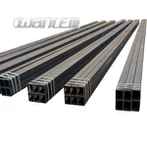Surface Treatment Methods for Steel Pipes
Surface treatment methods for steel pipes are critical factors determining their corrosion resistance, aesthetic appeal, service life, and specific functional properties (such as insulation and wear resistance). Below is a detailed explanation of mainstream and specialized surface treatment techniques within the industry.
These treatment methods can generally be divided into three major categories: metal coatings, non-metallic coatings, and chemical treatments.
Metallic Coatings
Coating the surface of steel pipes with another metal through electrochemical or hot-dip methods to provide cathodic protection (sacrificial anodes) or barrier protection.
|
Processing Method |
Principles and Features |
Primary Applications |
|
Hot-Dip Galvanizing, (HDG) |
The steel pipe is immersed in molten zinc at approximately 450°C to form a zinc-iron alloy layer. The coating is thick and highly durable (typically lasting 20-50 years outdoors), featuring zinc flowers. |
Building structures, guardrails, transmission towers, water pipes, scaffolding |
|
Electro-Galvanizing |
Electrolytic zinc coating deposits a layer of zinc onto the steel pipe surface. The coating is thin, with a uniform and smooth surface, but its corrosion resistance is significantly lower than that of hot-dip galvanizing. |
Electrical components, furniture, automotive interior parts |
|
Bimetallic Lining |
A layer of stainless steel or alloy is bonded to the inner wall of carbon steel pipes through extrusion, explosion bonding, or lining processes. This approach balances strength and corrosion resistance but incurs higher costs. |
Petrochemical industry, offshore platforms, transportation of highly corrosive media |
Non-Metallic Coatings
A non-metallic material is applied to the surface of steel pipes through spraying, winding, or sintering to provide an insulating barrier for protection.
|
Processing Method |
Principles and Features |
Primary Applications |
|
Epoxy Coating |
Spray powder or liquid epoxy resin and cure. Features strong adhesion, chemical resistance, and insulation. Common types include FBE. |
Oil and gas pipelines, water pipelines, construction steel bars |
|
3PE/2PE Anti-Corrosion Coating |
Three-layer structure: Epoxy primer (FBE) + adhesive + polyethylene outer layer. Combining the adhesion of epoxy with the mechanical protection of polyethylene, it represents the gold standard for buried pipelines. |
Long-distance oil and natural gas pipelines, urban pipeline networks |
|
Polyethylene/Polypropylene Coating (PE/PP) |
Extruded polyethylene/polypropylene layer. Provides excellent mechanical protection and waterproofing, but offers lower adhesion than epoxy. |
Municipal water supply and drainage pipelines, protective casings |
Chemical Treatments
A conversion coating is formed on the surface of steel pipes through a chemical reaction to enhance corrosion resistance or provide a suitable substrate for subsequent coating applications.
|
Processing Method |
Principles and Features |
Primary Applications |
|
Phosphating |
Immerse in the phosphating solution to form a porous phosphate crystal film. This primarily enhances coating adhesion and provides short-term rust prevention. It is an essential pretreatment step for cold-drawn tubes and electrophoresis. |
Automotive parts, mechanical components (for paint priming) |
|
Blackening/Bluing |
When heated in high-temperature alkaline solutions or in air, a dense film of iron(III) oxide (Fe₃O₄) forms on the surface, appearing blue or black. This provides an attractive finish and offers mild rust protection. |
firearms, tools, fasteners |
|
Pickling & Passivation |
For stainless steel only. Acid pickling removes welding scale, while passivation using nitric acid or citric acid promotes the formation of a chromium-rich oxide film on the surface, significantly enhancing corrosion resistance. |
All stainless steel welded pipes and equipment |
|
Anodizing |
For use exclusively on aluminum alloy tubes. Electrolytic oxidation produces a hard, wear-resistant, corrosion-resistant aluminum oxide coating that can be dyed. |
Aerospace, Architectural Curtain Walls, Consumer Electronics |
Selection Guide and Summary
|
Selection Criteria |
Recommended Course of Action |
|
Outdoor structures, long lifespan, low cost |
HDG |
|
Buried Piping, Highest Corrosion Protection Grade |
3PE Anti-Corrosion |
|
Highly decorative, wear-resistant |
Electroplated chrome / Electroplated nickel |
|
Chemical-resistant, food-grade |
Epoxy coating / Stainless steel passivation |
|
Improving Coating Adhesion (Pre-treatment) |
phosphating |
|
Restoration of Corrosion Resistance in Stainless Steel After Welding |
Pickling and Passivation |
Key Points
| Surface pretreatment is critical | Regardless of the method used, the rust removal, degreasing, and cleanliness of the steel pipe surface form the foundation for determining the final coating's quality and service life. |
| Select based on requirements | There is no "best" coating, only the "most suitable" one. Selection must comprehensively consider the operating environment, media, design life, and cost budget. |

We are able to provide high quality Corrosion-resistant Pipes according to customers' needs and look forward to your purchase.









